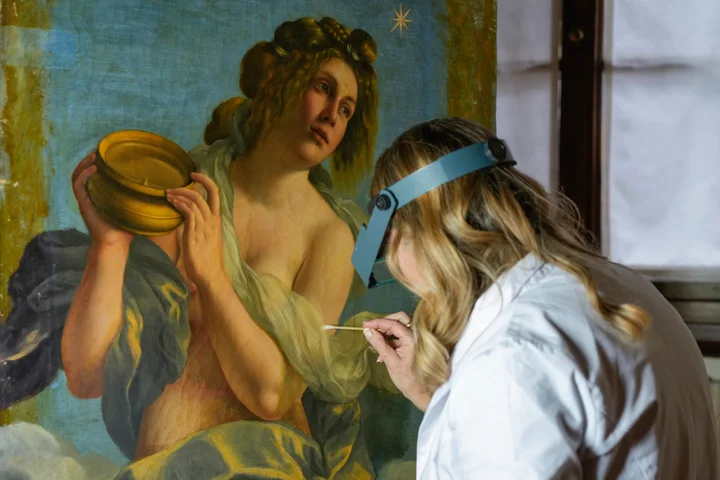After centuries in the shadows—many of her paintings were long misattributed to other artists, including her father Orazio—the Italian painter Artemisia Gentileschi (1593–1654) has finally earned her place among the foremost artists of the Caravaggio school. Known primarily for her powerful canvases such as Judith Slaying Holofernes and Jael and Sisera, Gentileschi is now widely recognized as one of the few female painters of her era who managed to infuse her subjects with intense drama and masterful use of light, hallmarks of the Baroque masters.
A new exhibition titled “Artemisia Gentileschi: Heroine of Painting”, currently on view at the Musée Jacquemart-André in Paris, takes a fresh look at her legacy and artistic achievements.
Featuring 40 works—including several significant pieces recently rediscovered—the exhibition highlights Gentileschi’s mastery while intentionally shifting the conversation.
“We didn’t want to focus on the rape,” said curator Patrizia Cavazzini. “Not because we think it’s irrelevant, but because for the last 80 years, that’s all anyone has talked about.”
The Girl, the Woman, the Artist
Born in Rome on July 8, 1593, Artemisia Gentileschi was the daughter of painter Orazio Gentileschi. Trained alongside her brothers in her father’s workshop, she painted her first acclaimed piece, Susanna and the Elders, at the age of just 17. The painting portrays two older men spying on a young woman as she bathes—a harrowing theme of voyeurism and power.
At 18, Artemisia was raped by Agostino Tassi, her perspective teacher and collaborator of her father. Tassi, who was under papal protection, promised to marry her but never fulfilled the vow. Nine months after the assault, Orazio took legal action against him. The seven-month trial, a major scandal in 17th-century Rome, ended with Tassi's release, while Artemisia endured public humiliation and even torture to validate her testimony.
This brutal experience left lasting emotional scars. The court transcripts, published in recent years, offer a raw glimpse into the moral climate of the time.
Artemisia’s path was severely limited by her circumstances. Her father arranged a hasty marriage to a much older and relatively obscure Florentine painter-merchant. She left Rome for Florence, closing the first act of her turbulent life.
But her art flourished.
Florence, while aristocratic, was artistically conservative by that point. Gentileschi’s bold and modern artistic voice stood out, earning her both fame and generous commissions. Her fees were often triple those of her male peers—especially notable considering she worked alongside artists decorating the Casa Buonarroti, under the patronage of Michelangelo Buonarroti the Younger, grandnephew of the Renaissance master.
At just 23, Artemisia became the first woman admitted to Florence’s Accademia delle Arti del Disegno, securing her status as a court painter and a favorite of the Medici family.
Women Who Fought Back
Her body of work centers around women—biblical, mythological, and historical—who were wronged, betrayed, raped, or seduced by men, and who often sought justice or revenge. From Bathsheba and Esther to Delilah, Jael (who drove a tent peg through Sisera’s temple), Salome, Lucretia, and Cleopatra, Gentileschi elevated these figures into complex, powerful heroines.
Rediscovered Masterpieces
Among the highlights of the Paris show is Virgin of the Annunciation (c. 1610), one of Gentileschi’s best-known early works.
“What always struck me was her willingness to defy conventions,” Cavazzini noted, pointing to the many bold and often scandalous ways Gentileschi continued to break societal norms.
“Self-Portrait as a Lute Player,” Artemisia Gentileschi, 17th century
(AP Photo/Andrew Medichini)
One of the newly discovered works is a signed portrait of a knight of the Order of Saint Stephen, likely painted around 1619. Originally misattributed to Flemish painter Justus Sustermans, the work was re-identified when Gentileschi’s faded signature was uncovered beneath layers of grime.
Many of her paintings remain lost—known only through historical records and archival mentions. That’s why the inclusion of Ulysses Recognizing Achilles Among the Daughters of Lycomedes (c. 1640), a dramatic retelling of a Greek myth, is so significant for curators.
“The deeper you go into Gentileschi’s life, the more extraordinary she becomes,” said Cavazzini.
While she frequently depicted women confronting or defying male power, she also infused her subjects with personal expression. Cavazzini hopes to spotlight another lesser-known but equally daring aspect of her work: her use of her own body and face in her art. “She knew how to use her image and could be incredibly seductive,” she said.
This self-reflective quality is particularly evident in Allegory of Inclination (1616), commissioned by Michelangelo’s descendant. The painting features a life-size nude woman floating in the clouds, thought to be a stylized self-portrait.
Years ago, conservators in Florence restored the work, which had been modified to veil the woman’s bare chest. For the first time, it has traveled outside Italy for this exhibition.
Another rediscovered gem is a new portrait of Cleopatra, a subject Gentileschi returned to multiple times. In this version, the Egyptian queen is portrayed partially nude, turning her head in anguish as the serpent’s fangs pierce her breast—moments after the death of her lover, Mark Antony.
“When people began to take interest in Artemisia about 25 years ago, we didn’t know much about her work, so she wasn’t fully included among the greats,” Cavazzini reflected. “Now, I’m thrilled that we finally have a fuller and clearer picture of her immense talent.”
This landmark exhibition not only reclaims Gentileschi’s rightful place in art history—it allows us to witness her resilience, audacity, and vision through the vibrant legacy of her brush.








